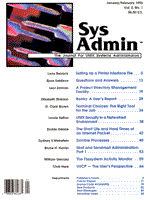
Sidebar: Glossary
ICMP -- Internet Control Message Protocol. Used by hosts and routers to inform neighbors of problems, better routes, or other control information. The ping command takes advantage of the ICMP "echo request" to determine if a remote host is capable of responding. Internet -- When capitalized, it refers to the vast number of networks throughout the world that are most often attached by leased or dial-up lines. Otherwise, it refers to any network of networks. packet/datagram -- Often used interchangeably, a packet strictly refers to the data sent through a packet-switched network while a datagram is often used to denote not just the data but the headers as well. protocol stack -- Conceptually, several protocol definitions, each of which passes data to the protocol "above" or "below" it. The typical suite of protocols consists of layers such as ethernet, IP, TCP, and an application program. router/gateway -- Both terms are often used very loosely. A router (or gateway) attaches to more than one network and decides which way to direct packets. In the context of the IP protocol, gateways and routers are equivalent. Otherwise, a router is more often used to denote a device that forwards packets of the same protocol, while a gateway forwards packets between different protocols. TCP/IP -- Transmission Control Protocol/Internet Protocol. Very often, "TCP/IP" is used to describe the Internet protocols, and vice versa. The full name is "TCP/IP Internet Protocol Suite." A full definition of either TCP or IP is beyond the scope of a simple glossary. UDP -- User Datagram Protocol. If a virtual circuit is not required by the application program, then UDP may be the better choice than TCP, since does not have so much overhead. UDP still allows programs to use port numbers in order to multiplex among different applications, but is not burdened with the complexity required by TCP's guaranteed delivery. virtual circuit -- A reliable data stream between, in the case of Internet protocols, two TCP modules. Regardless of the path taken by multiple packets, and regardless of the time taken by those packets in transit, TCP attempts to make it appear to the application program that there is an error-free line between the two machines. WAN -- Wide Area Network. Usually refers to geographically disparate nodes or local networks linked by dial-up or leased lines.
|